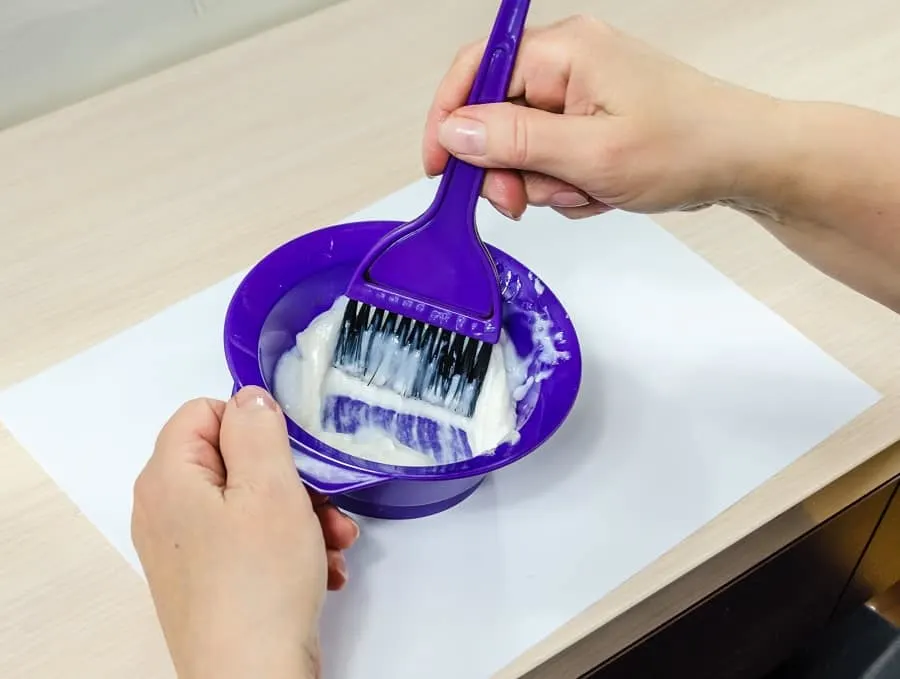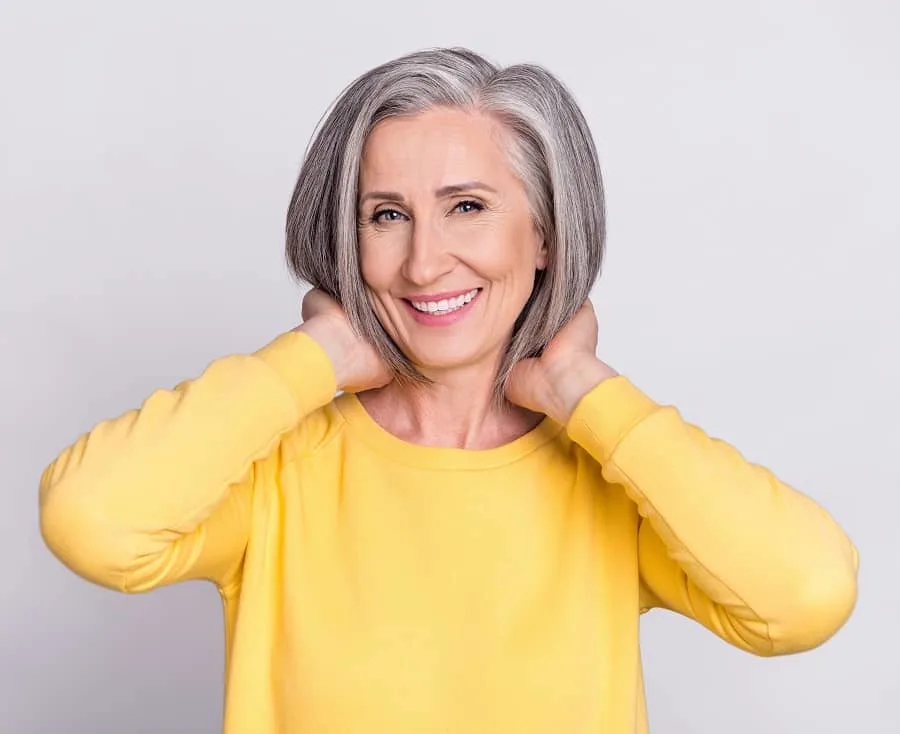Grey hair used to be something people wanted to pluck out of their heads or dye to mask. But more and more people are embracing the beautiful shades of natural gray that appear with age.
One of the main ways people embrace their gray hair is by adding highlights and lowlights to add dimension and make it feel less gray. Adding high and lowlights is a great option if you’re ready to make your gray hair feel more dimensional and fun.
Whether you want to add dimension to your entirely gray hair, hide your new gray hair growth, or another reason, we’re here to help. We’ll talk about why blending highlights and lowlights with gray hair is ideal, how to do it at home and how to care for your hair afterward.
Why Blend Gray Hair With Highlights and Lowlights?

- tevelyn79/Instagram
There are numerous reasons why you might want to blend your gray hair growth with some high or lowlights. Just like highlights and lowlights help add dimension and create a beautifully blended look on brown, blonde, and other hair colors, gray hair can really benefit from highlights and lowlights.
Blending different colors into your gray hair can make it feel less dull and even make you appear younger if that’s something you’re looking for.
It helps hide the grays more without fullying dying your entire head. Blending gray hair with a suitable shade for your hair will add depth, the illusion of volume, and texture to your hair.
How To Blend Gray Hair With Highlights and Lowlights at Home

You don’t necessarily need to head to a salon to achieve a beautiful hairdo with highlights and lowlights. If you’re ready to disguise gray hair with highlights and lowlights, here’s how you can do it at home.
Step 1: Choose a Suitable Shade
Before you can begin dying your hair, you need to decide on a suitable shade for your hair. The critical component of choosing an appropriate highlight or lowlight shade is your base color or natural hair color.
For those desiring to highlight their hair to hide their grays peaking through, choosing a color close to your base color can help with this, and it’s the most natural.
If you’re ready to embrace a full head of gray hair, but you’re still in the process of growing it out, lowlights are a great move in the meantime. It helps create a great transition color for your hair that you’ll love.
Another factor to consider when choosing a suitable shade is your skin tone and eye color. These will help identify how warm or cool of a color you might want to go with that will look the best on you.
Step 2: Decide Where You Want the Highlights or Lowlights
Several parts of your hair are ideal for highlighting and lowlighting, and it will ultimately come down to your personal preference.
Highlights look excellent on the higher part of your hair where the sun would hit, so near the face and top layers, while lowlights are ideal for blending into your natural color on the lower layers.
There are also a lot of different techniques for adding highlights and lowlights to your hair. You can go with classic high and lowlights, balayage, or babylights to get the desired dimension and end result.
Step 3: Get Your Hair Ready
Once you’ve chosen your shade and where you’ll want to put the high or lowlights, you can get your hair ready for the color. Here’s what you’ll want to do to prepare your hair for a dye job:
- Wash your hair with a clarifying shampoo and cool water
- Brush through your hair to ensure there are no tangles
- Part your hair where you want your hair to fall
- Create sections where you’ll apply the dye
- Use a rat comb to tease hair, leaving out the pieces you’ll highlight or lowlight
Step 4: Prepare Your Dye
Now you need to prepare your dye. Here’s the best way to prepare your dye and tools for your DIY hair job:
- Cut up pieces of aluminum foil
- Add your hair color to a bowl
- Add your 20-volume developer to the bowl per the ratio listed on the dye
- Combine your ingredients well with a brush
- Put on a cape or something to protect your clothes
- Grab some gloves, so the hair color doesn’t stain your hands
Step 5: Apply the Lowlights or Highlights
Once you’ve gotten your dye prepared and are ready to start, here’s how you can apply the lowlights or highlights to blend your gray hair:
- Clip your hair into sections
- Place a piece of aluminum foil underneath each section
- Brush the dye onto your hair
- Fold the foil to encase the hair dye
- Repeat until you cover all the sections you want to with dye
How To Maintain Gray Hair With Highlights or Lowlights

Once you complete the color treatment, maintenance is necessary to keep your hair looking beautiful. Here are a few tips for maintaining the highlights or lowlights in gray hair.
- Refrain From Taking Really Hot Showers: Overly hot water produced by your shower can make the highlights and lowlights in your hair fade faster. Rinsing your hair with water that is too hot can also cause lasting damage.
- Avoid Heat Treatments: Similar to hot water, overexposure to heat of any kind can cause damage your hair. This damage can be compounded when dealing with color-treated hair.
- Try Using Heat Protectants Before Styling: Heat protectants form a silicone barrier on your hair, preventing heat from permeating your hair’s cortex and causing long-term damage.
- Touch-Up Roots: The natural growth of your hair impacts its overall appearance. Stylists recommend touching up your roots every four to six weeks to maintain the full effect of your highlights or lowlights.
- Use Hair Masks: Hair masks use a highly concentrated conditioner to penetrate your hair’s roots and repair damage. A hair mask can significantly help retain your hair’s moisture and reduce the appearance of fading.
- Apply an After-Color Sealer: After-color sealers work to prevent fading by locking in the color. You can apply an after-color sealer directly after treating your hair to keep your highlights and lowlights from fading.
- Use a Hydrating Conditioner: Hydration is essential for maintaining color-treated hair. Stylists recommend incorporating a hydrating conditioner into your showering routine at least once weekly for optimal results.
- Be Kind To Your Hair: Avoid over-washing your hair with shampoo or treating it with other harsh chemicals. Instead, using sulfate-free shower products can go a long way in maintaining your highlights and lowlights.
By following these tips, you can maintain the highlights and lowlights in your gray hair for longer. However, avoiding heat and hydrating your hair are the two most essential ways to ensure your hairstyle lasts.
Frequently Asked Questions
Do you still have questions about blending gray hair with highlights and lowlights? Here are a few answers to the most commonly asked questions.
How long do highlights or lowlights last?
Highlights and lowlights last, on average, two to three months, but it can vary depending on hair care and hair type.
How often is maintenance needed?
Depending on your preference, it’s recommended that you revamp your highlights or lowlights every six to eight weeks to maintain a fresh appearance.
Can you use highlights and lowlights together?
Adding highlights and lowlights together is an excellent idea so that the lowlights can compliment your base hair color while the highlights make things brighter.
Are babylights the same as highlights and lowlights?
Babylights aren’t the same as highlights and lowlights, but they’re similar. Babylights highlight the hair, but stylists will use more sections with thinner pieces of hair than they would with high and lowlights.
Conclusion
Blending gray hair with lowlights and highlights is one of the best ways to hide gray strands without undergoing a complete gray coverage or committing to having a full head of silver hair. They add dimension, depth, texture, and more to your hair.
Once you add lowlights and highlights to your hair, you’ll want to ensure you take care of your color-treated hair by avoiding heat products and hot hair and using products designed for color-treated hair.
Choosing the right shades and taking care of your newly blended gray locks will give you the confidence you crave for a beautiful new hairdo.
